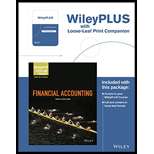
Concept explainers
Accounts receivable:
Accounts receivable refers to the amounts to be received within a short period from the customers, upon the sale of goods and services on account. In other words, accounts receivable are amounts customers owe to the business. Accounts receivable is an asset of a business.
Bad debt expense:
Bad debt expense is an expense account. The amounts of loss incurred from extending credit to the customers are recorded as bad debt expense. In other words, the estimated uncollectible accounts receivable are known as bad debt expense.
Allowance method:
It is a method for accounting bad debt expense, where uncollectible accounts receivables are estimated and recorded at the end of particular period. Under this method,
To prepare: The
To prepare: The journal entry in the books of Company L, to record the write off the uncollectible accounts receivables.
To prepare: The journal entry in the books of Company L, to record the recovery of the accounts receivables.
To prepare: The journal entry in the books of Company L, to record the amount of cash collected on account.
Want to see the full answer?
Check out a sample textbook solution
Chapter 8 Solutions
Financial Accounting, 10e WileyPLUS Registration Card + Loose-leaf Print Companion
- I need help finding the accurate solution to this financial accounting problem with valid methods.arrow_forwardNashville Enterprises wishes to earn a pre-tax income of $40,000. Total fixed costs are $96,000, and the contribution margin per unit is $8.00. How many units must be sold to earn the targeted net income?arrow_forwardPlease explain the solution to this general accounting problem with accurate principles.arrow_forward
- Can you explain the correct approach to solve this general accounting question?arrow_forwardHow does resource consumption sequencing affect cost accumulation? (a) Sequence remains irrelevant (b) Random recording works fine (c) Usage patterns determine proper recording order (d) Standard methods fit allarrow_forwardShri Manufacturing has estimated total factory overhead costs of $625,000 and 25,000 direct labor hours for the current fiscal year. If direct labor hours for the year total 23,500 and actual factory overhead totals $610,000, what is the amount of overapplied or underapplied overhead for the year?arrow_forward

 AccountingAccountingISBN:9781337272094Author:WARREN, Carl S., Reeve, James M., Duchac, Jonathan E.Publisher:Cengage Learning,
AccountingAccountingISBN:9781337272094Author:WARREN, Carl S., Reeve, James M., Duchac, Jonathan E.Publisher:Cengage Learning, Accounting Information SystemsAccountingISBN:9781337619202Author:Hall, James A.Publisher:Cengage Learning,
Accounting Information SystemsAccountingISBN:9781337619202Author:Hall, James A.Publisher:Cengage Learning, Horngren's Cost Accounting: A Managerial Emphasis...AccountingISBN:9780134475585Author:Srikant M. Datar, Madhav V. RajanPublisher:PEARSON
Horngren's Cost Accounting: A Managerial Emphasis...AccountingISBN:9780134475585Author:Srikant M. Datar, Madhav V. RajanPublisher:PEARSON Intermediate AccountingAccountingISBN:9781259722660Author:J. David Spiceland, Mark W. Nelson, Wayne M ThomasPublisher:McGraw-Hill Education
Intermediate AccountingAccountingISBN:9781259722660Author:J. David Spiceland, Mark W. Nelson, Wayne M ThomasPublisher:McGraw-Hill Education Financial and Managerial AccountingAccountingISBN:9781259726705Author:John J Wild, Ken W. Shaw, Barbara Chiappetta Fundamental Accounting PrinciplesPublisher:McGraw-Hill Education
Financial and Managerial AccountingAccountingISBN:9781259726705Author:John J Wild, Ken W. Shaw, Barbara Chiappetta Fundamental Accounting PrinciplesPublisher:McGraw-Hill Education





